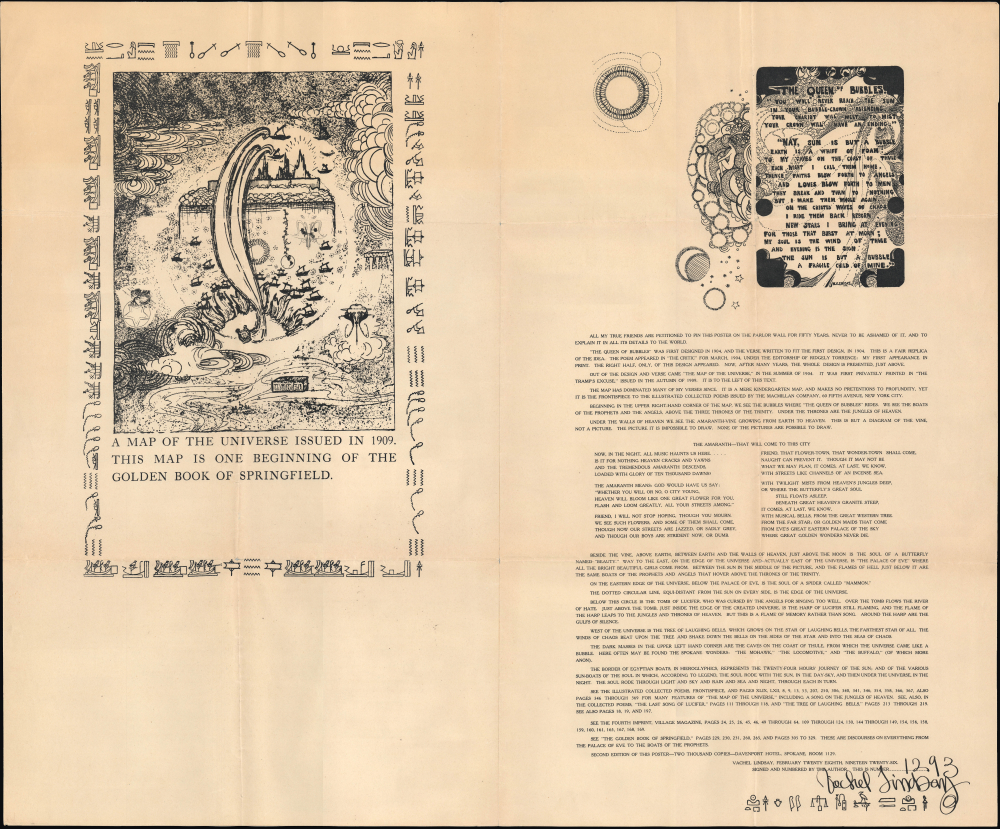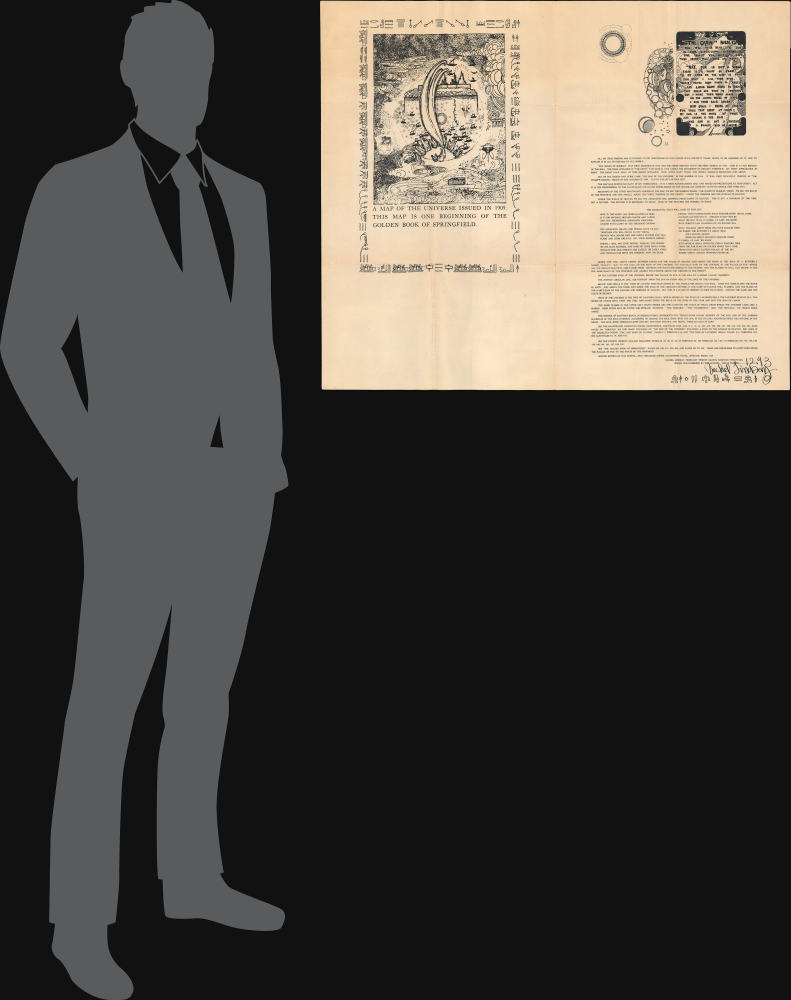1926 Vachel Lindsay Signed 'Map of the Universe,' Poetry
MapOfTheUniverse-lindsay-1926
Title
1926 (dated) 26.75 x 31.25 in (67.945 x 79.375 cm)
Description
A Closer Look
The sheet is divided in two, with the left-hand side including the 'map of the universe,' which refers to Lindsay's 1920 novel The Golden Book of Springfield, while the right-hand side includes illustrations relating to Lindsay's poem 'The Queen of Bubbles' as well as an additional poem 'The Amaranth,' text explaining the purpose of the poster, and references to portions of Lindsay's work relating to the illustrations.The Golden Book of Springfield is often classified as a work of utopian fiction, describing Lindsay's hometown of Springfield, Illinois as imagined to exist one hundred years in the future, in 2018. Though deeply rooted in Christianity, Lindsay's utopian vision of a multicultural future Springfield draws on a wide range of religious traditions and social movements, including Tibetan Buddhism, anticipating the New Age movement by several decades.
Akin to his poetry but in prose form, Lindsay's text is difficult to say the least; a representative passage: 'The Thibetan Boy takes me, in one instant, to the far edge of Space and Time, way beyond the North Star and its dandelions. And as we stand on the shaking shore of Space and Time we see and hear, rolling in from Chaos, endless smoke and glory and darkness and dissolving foam.' The 'Map of the Universe' depicted here includes depictions of futuristic Springfield, UFO-like flying machines, and the universal 'ascension' discussed in the last part of the book. The map is surrounded by hieroglyphs representing the 'twenty-four hours' journey of the sun.' As the text at right explains, Lindsay first privately printed the map in 1904 and it was an ongoing theme or muse in Lindsay's work for years.
'The Queen of Bubbles' was also an important representation of Lindsay's larger musings on the human condition and the nature of the cosmos, the imagery of which he describes at length below the illustration. 'The Amaranth,' including in this description of 'The Queen of Bubbles,' anticipates The Golden Book of Springfield with its allusions to a great future city in harmony with the universe. Both poems were in a formative stage at the time, and when ultimately published would differ considerably. It is notable that both 'The Map of the Universe' and 'The Queen of Bubbles' were first conceived in 1904, the year when Lindsay first had intense mystical-religious visions.
Publication History and Census
This sheet, including the illustrations, was prepared by Lindsay in a limited run of 2,000, all of which he signed. It followed a first edition of the broadside, printed in a run of 500 in 1924 (OCLC 18399074). Selling these signed works was likely a means of ameliorating his financial difficulties at the time (see biography below). This edition of the signed 'Map of the Universe' is well-represented in institutional collections but fairly scarce to the market.Cartographer
Nicholas Vachel Lindsay (November 10, 1879 - December 5, 1931) was a romantic American poet, novelist, performance artist, and early film critic - sometimes called the 'prairie troubadour.' He pioneered 'singing poetry,' writing verses meant to be chanted or sung with rhythmic gestures to connect with everyday audiences. Lindsay was born in Springfield, Illinois and grew up across the street from the Illinois Executive Mansion, and was steeped in civic and political life from a young age. Lindsay originally studied medicine at Hiram College in Ohio (his father was a doctor) but left to attend the Art Institute of Chicago and then the New York School of Art (now The New School). While in New York, Lindsay became increasingly focused on poetry, though he continued to draw and often produced illustrations relating to his poetry and writing. In the spring of 1906, Lindsay walked hundreds of miles through the eastern U.S., going town to town selling his self-published poetry or trading poems for food and lodging, the basis of his 'Prairie Troubadour' nickname. In 1912, he undertook a similar trek from Illinois to New Mexico. Rather than simply distributing his poems, Lindsay read them from a stage in a highly expressive, wild, exaggerated manner with lines sung rather than read, reflecting the influence of vaudeville performers and carnival barkers as much as other poets. Although little known today, Lindsay was among the best-known American poets of the 1910s and is credited with 'discovering' Langston Hughes. However, his personal and professional life deteriorated in the 1920s, with his 1920 The Golden Book of Springfield being a commercial and critical failure. His troubles were punctuated by the wider economic troubles following the 1929 stock market crash. Facing steep financial and health problems, Lindsay committed suicide in December 1931. More by this mapmaker...




